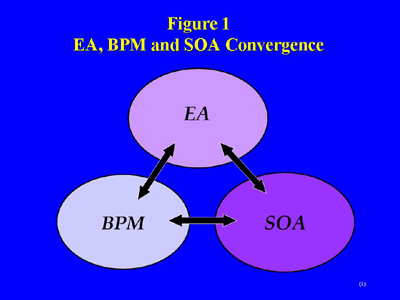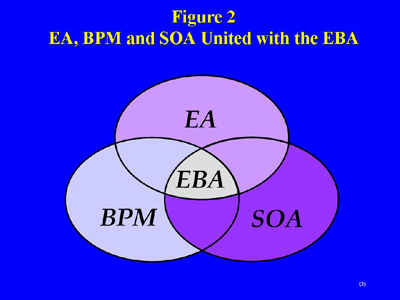Many strategic initiatives today are focused on Enterprise Architecture (EA) development, Business Process Management (BPM) and Service-Oriented Architecture (SOA) development. In support of these important activities are numerous approaches, techniques, tools and experienced consultants. You can also find a wealth of information on the web and in various industry newsletters and publications. Let us take a look at what is common and shared between these essential initiatives.
Most of us are familiar with the various EA frameworks, such as the Zachman Framework, The Open Group Architecture Framework (TOGAF) and the Department of Defense Architecture Framework (DoDAF). If you consider the Zachman Framework, and look at row two, column two, you will find in this cell a reference to the Business Process Models. These are the processes that BPM is designing, improving and reengineering. If you consider how best to satisfy the needs of these newly designed processes in today’s web environment, you obviously will consider SOA. And many realize that SOA’s potential lies in its ability to align software resources with business processes.
It is sometimes hard to discuss one of these strategic initiatives without referring to the other two. As these initiatives mature, each one is complementing the other, almost co-evolving as each develops. You might realize that these three initiatives share many common resources or maybe you see a convergence of the three. Please refer to Figure 1.
Figure 1. EA, BPM and SOA Convergence

If you consider how EA has matured from the very early days, it was sometimes referred to “architecture in the dark.” However, today with the available EA frameworks and supporting software tools, it is “architecture by design.” In a similar fashion, process modeling has grown up from independent, functional, stovepipe activity diagrams to well defined, robust cross-functional process models. And here again, several BPM suites of software are available. SOA is developing also, expecting to achieve reuse of IT assets, interoperability, scalability and shorter development life cycles.
As these strategic initiatives continue to evolve, mature and converge, you will find that they share something in common; an architecture of the business. The Enterprise Business Architecture (EBA) is a blueprint of the enterprise built using architectural disciplines to improve performance. The IT community is certainly no stranger to architecture development and engineering disciplines. Perhaps it will seem strange to the business community that they too have a formal architecture that can be engineered. The EBA has a customer centric focus coupled with a holistic view of the enterprise, to deliver a value creating system. It is built using value streams and integrated by connecting the inputs and outputs of all processes with their appropriate sources and destinations.
The EBA represents the area of convergence or the unification of these three major initiatives. Please refer to Figure 2.
Figure 2. EA, BPM and SOA Convergence

Here again, you can not simply address one without the other, but you must consider each of these as part of a unified whole, and not as a loosely defined stand alone project. Considering this point of view, you may find the true potential of EA, BPM and SOA is in their unification through the EBA rather than as stand alone corporate initiatives. With this kind of insight, you may find that you are creating higher profits, superior customer service and a competitive advantage for the enterprise.

















